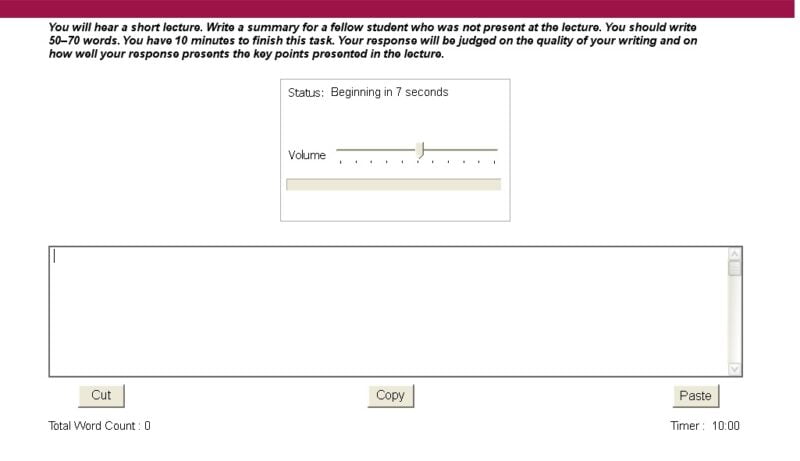
The Summarize Spoken Text section of the PTE Academic test is a critical component designed to assess your ability to comprehend and summarize spoken English. In this task, you’ll listen to a short audio clip, usually around 60 to 90 seconds long, and then summarize its content in 50-70 words. You are given 10 minutes to complete this task. The test is challenging because it requires you to actively listen, extract key information, and then succinctly convey that information in written form—all within a limited timeframe.
What to Expect in the Summarize Spoken Text Task
Audio Length and Content
- The audio you’ll hear is typically a lecture, a news report, an interview, or a discussion on academic topics. It could cover a wide range of subjects, from science and technology to history and the arts.
- The audio lasts for 60-90 seconds, and you only get to listen to it once.
Time Limit
- After listening to the audio, you have 10 minutes to write your summary. This time includes both writing and proofreading your response.
Word Count
- Your summary should be between 50 to 70 words. Staying within this word limit is crucial, as writing fewer or more words than required can negatively impact your score.
Scoring Criteria
- Your response is evaluated based on Content, Form, Grammar, Vocabulary, and Spelling.

How to Approach the Summarize Spoken Text Task
Given the challenges of this task, it’s essential to have a clear strategy. Here’s a step-by-step guide:
1. Active Listening:
- Focus on the Main Idea: The first thing you should do is grasp the main idea of the audio. Listen to the speaker’s thesis, key points, and conclusions. Avoid getting bogged down by minor details.
- Identify Key Information: Pay attention to key phrases, numbers, dates, or names that are critical to the content. These are often central to the summary. Example: Suppose you hear a lecture about climate change, focusing on the effects of global warming on polar bears. The key points might include the melting ice caps, the shrinking habitat of polar bears, and the resulting impact on their population.
2. Taking Notes:
- Use Short Forms and Symbols: While listening, jot down notes using abbreviations and symbols. For example, use “↑” for increase, “→” for leads to, “env” for environment, etc.
- Structure Your Notes: Organize your notes by separating them into different sections, like main ideas, supporting details, and examples. Example Notes:
- Global warming → ice caps melting → polar bears’ habitat shrinking → population decrease.
- Scientist X: polar bears losing hunting grounds.
- Date: Significant decline since the 2000s.
3. Writing the Summary:
- Start with a Topic Sentence: Your summary should begin with a clear sentence that encapsulates the main idea of the audio.
- Include Key Points: Briefly mention the key points, ensuring you stay within the word limit.
- Maintain Clarity and Coherence: The summary should be clear, concise, and coherent. Avoid repetition or overly complex sentences. Example Summary: “The lecture discusses the impact of global warming on polar bears, highlighting that the melting ice caps are shrinking their habitat, leading to a decline in their population. Since the early 2000s, scientists have observed a significant reduction in their numbers due to loss of hunting grounds.”
4. Proofreading:
- Check for Grammar and Spelling: Ensure that your summary is grammatically correct and free from spelling errors.
- Word Count: Make sure your summary is within the 50-70 word limit.
- Content Accuracy: Verify that you have accurately conveyed the main points of the audio.

Ready-made template for Summarize Spoken Text
One easy way to write a summary and guarantee a good score is to use a template to write the answer for Summarize Spoken Text.
For this, you should note down at least 15 words from the audio lecture you hear. It is best if you write nouns and verbs.
After picking out those words, you can fill them in the following template:
| Summarize Spoken Text Template |
|---|
| The lecture was about [word 1]. According to the speaker, there is great significance in [word 2], [word 3], and [word 4]. Thereafter, the lecturer highlighted the issues regarding [word 5], [word 6], and [word 7]. Additionally, the concepts of [word 8], [word 9], and [word 10] were explored in the audio. Likewise, the speaker shed light on [word 11], [word 12], and [word 13]. Finally, the lecturer concluded that [word 14] and [word 15] are vital. |
Listen to this audio clip:
From the audio, I picked out these 15 words.
| learning | process | models |
| look | representations | examples |
| code | beyond | course |
| research | pandemic | university |
| gives | lemon | visiting |
Now you just have to insert these words in the format above. It doesn’t really matter which words you choose from the audio.
| Summarize Spoken Text Sample Answer |
|---|
| The lecture was about learning. According to the speaker, there is great significance in process, models, and look. Thereafter, the lecturer highlighted the issues regarding representations, examples, and code. Additionally, the concepts of beyond, course, and research were explored in the audio. Likewise, the speaker shed light on pandemic, university, and gives. Finally, the lecturer concluded that lemon and visiting are vital. |
Helpful Tips and Strategies
Practice Active Listening:
- Improve your listening skills by regularly practicing with English audio materials such as podcasts, news reports, or academic lectures. Try summarizing these audio to get used to identifying key points quickly.
Expand Your Vocabulary:
- A broad vocabulary allows you to express complex ideas succinctly. Read extensively and take note of how concise language is used to convey detailed information.
Develop Note-Taking Skills:
- Effective note-taking is crucial. Practice shorthand writing and use symbols to quickly jot down key points while listening to audio clips.
Time Management:
- Use the first minute after the audio to quickly organize your thoughts. Spend the next 7-8 minutes writing and the last minute proofreading.
Familiarize Yourself with Different Topics:
- Since the audio could cover a wide range of subjects, familiarize yourself with various academic topics. This will help you understand and summarize the content more effectively.
Practice with PTE Mock Tests:
- Take practice tests under timed conditions. This will help you get used to the pressure of completing the task within the given timeframe.

Common Pitfalls to Avoid
Ignoring the Word Count:
- Failing to meet the word count requirement (50-70 words) can result in a lower score. Practice writing concise summaries to get a feel for how much information fits within the limit.
Not Proofreading:
- Simple grammar or spelling errors can easily be avoided by proofreading. Always leave a minute to review your work.
Relying on Memory Alone:
- Trusting your memory instead of taking notes can lead to missed details or inaccuracies in your summary. Always take notes while listening.
Conclusion
The “Summarize Spoken Text” task in the PTE Academic test is a comprehensive assessment of your listening and writing skills. By developing strong listening habits, effective note-taking strategies, and concise writing techniques, you can excel in this section. Remember, practice is key. Regularly expose yourself to diverse audio materials, take practice tests, and refine your summarization skills to ensure success on test day.
Gaurav Thapa is an experienced instructor of English as a Foreign Language. He has eight years of experience teaching IELTS and PTE.